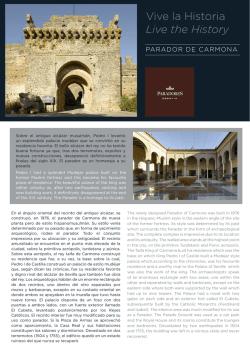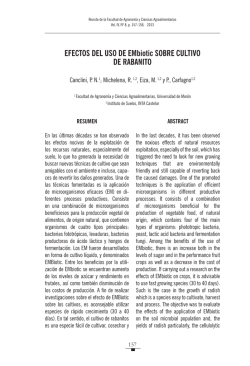
Folleto Vive la Historia. Parador de Baiona
Vive la Historia Live the History PARADOR DE BAIONA La península de Monterreal, frente a la ría de Vigo, tiene fama de ser una de las fortalezas más bellas de España. Realmente es un enclave privilegiado: magníficas vistas sobre la tierra y el mar, un pasado lleno de historia y, desde 1966, un parador de turismo que pone en valor su enorme belleza. The peninsula of Monterreal, opposite the estuary of Vigo, is famous for being one of the most beautiful fortresses in Spain. It is a privileged enclave with magnificent views of the land and the sea, a past full of history and a Tourism Parador since 1966, which contributes to the value of its wonderful beauty. En esta península de apenas dieciocho hectáreas ha habido asentamientos humanos desde la antigüedad por su especial ubicación frente a la ría. Primero existió un castro y luego una construcción militar con muralla defensiva conocida como castillo de Monterreal. En el siglo XIX, un nuevo edificio sustituyó la fortaleza medieval. El palacio Elduayen, de propiedad privada, que el Estado compró en 1963 para instalar un parador en la península, se consideró de imposible aprovechamiento y se proyectó un moderno establecimiento de nueva planta. Éste se edificó pensando en las vistas y las condiciones de humedad e insolación de la zona. Para ello se diseñó un cuerpo central sensiblemente rectangular con un amplio patio interior protegido y otro cuerpo con un patio abierto orientado hacia el sur. Se proyectó igualmente una bodega típica en las antiguas caballerizas y se restauraron parte de las murallas de la península. Due to its special location opposite the estuary, there have been human settlements from ancient times on this peninsula measuring scarcely eighteen hectares. First there was a hill fort and then a military construction with a defensive wall known as the Castle of Monterreal. In the XIX century, a new building replaced the medieval fortress. The privately owned Palace of Elduayen, which was bought by the State in 1963 in order to install a Parador on the peninsula, was considered impossible to make use of and a newly designed modern establishment was planned. This was built thinking of the views and the humidity and sunshine conditions of the area. To achieve this, a central noticeably rectangular structure with an extensive protected interior patio and another structure with an open patio oriented to the south were designed. A typical wine cellar was planned in the old stables and part of the walls of the peninsula were restored. EL CONDE DE GONDOMAR DEFIENDE LA PENÍNSULA DE MONTERREAL Siempre asediada por piratas, la ría sufrió uno de sus peores ataques en 1585 cuando el inglés Francis Drake, asaltó la fortaleza de Monterreal con una importante flota. Fue la valentía y la estrategia de Diego Sarmiento de Acuña, conde de Gondomar, lo que consiguió contener el ataque. Diego Sarmiento de Acuña, primer Conde de Gondomar (15671626), hijo del gobernador de Galicia estuvo toda su juventud muy unido a esta tierra ya que siendo muy joven recibió de Felipe II el mando militar de la frontera portuguesa y la costa gallega. Demostró su valía durante la guerra franco-española de 1585-1604, cuando consiguió repeler una grave incursión inglesa en 1589 y fue nombrado Gobernador de la Gente de Guerra de Bayona y del Castillo de Monterreal, ligando su nombre para siempre a esta península. Hasta dos veces más fue llamado por el rey para acudir a la costa gallega: primero para supervisar el desembarco del cargamento de dos galeones de la Carrera de Indias, refugiados en Vigo en su ruta hacia el puerto de Sevilla y, en 1609, una vez más, para resistir un ataque naval de los rebeldes holandeses. A partir de ese momento, el conde de Gondomar sirvió en otros puestos ya que fue embajador de España en Londres entre 1613 y 1622 siendo considerado un excelente diplomático y hábil negociador. Su amistad personal con el rey Jacobo I consiguió contener momentáneamente los ataques ingleses a las flotas americanas españolas y mantener la paz entre España y Gran Bretaña. A su vuelta a Madrid fue reclamado para otra misión diplomática en Viena que no pudo terminar porque murió repentinamente en 1626. THE COUNT OF GONDOMAR DEFENDS THE PENINSULA OF MONTERREAL Forever besieged by pirates, the estuary suffered one of the worst attacks in 1585 when the Englishman, Francis Drake, attacked the fortress of Monterreal with a substantial fleet. It was the bravery and strategy of Diego Sarmiento de Acuña, Count of Gondomar, which made it possible to contain the attack. Diego Sarmiento de Acuña, the first Count of Gondomar (1567-1626), the son of the Governor of Galicia had a very close relationship with this land because when he was very young received the military command of the Portuguese frontier and the coast of Galicia from King Felipe II. He demonstrated his value during the Anglo-Spanish War of 1585-1604 when he managed to repel a serious English raid in 1589 and was appointed Governor of the Warring People of Bayona and of the Castle of Monterreal, linking his name to this peninsula for ever. On two further occasions he Retrato de Diego Sarmiento de Acuña, Conde de Gondomar. (Biblioteca Nacional de España) was called by the king to go to the coast of Galicia: first to supervise the disembarking of the cargos of two galleons of the Indies Run, which had taken refuge in Vigo en route to the port of Seville and, in 1609, again to combat a naval attack of the Dutch rebels. From this time, the Count of Gondomar served in other posts as he was the Spanish Ambassador to London between 1613 and 1622 and was considered to be an excellent diplomat and a skilful negotiator. His personal friendship with King James I made it possible to momentarily contain the English attacks on the Spanish fleets of the Americas and keep the peace between Spain and Great Britain. On his return to Madrid, he was required to carry out another diplomatic mission in Vienna which he could not terminate as he died suddenly in 1626. UN PASEO POR LAS MURALLAS DE MONTERREAL El perímetro de la península de Monterreal ocupa unos tres kilómetros y es un paseo muy aconsejable. A lo largo del recorrido hay torres, puertas, baterías, baluartes y restos de edificaciones como almacenes o pozos. Se recomienda detenerse, sobre todo, en: La Puerta Real (s. XVI) la más bonita del recinto y donde destacan dos escudos: el de la Casa de Austria, y el de la Casa de Sarmiento, la familia a la que pertenecía el conde de Gondomar. La Torre del Reloj (s. XVI) debe su nombre a que se instaló en ella un reloj y una gran campana para avisar en caso de ataque por mar. La Torre del Príncipe. La más antigua, existía ya en el siglo X aunque fue reconstruida en el siglo XVI ante los constantes ataques piratas. Servía de faro. La Torre de la Tenaza, cuyo cometido era defender el puerto mediante unas baterías de tiro. TAMBIÉN LE GUSTARÁ: YOU WILL ALSO LIKE THE FOLLOWING: Casco antiguo de Baiona. The old quarter of Baiona Ruta de las playas. The beach route Monte de A Groba. Mount A Groba A WALK BY THE WALLS OF MONTERREAL The perimeter of the peninsula of Monterreal is about three kilometres long and is a recommended walk. Along the route there are towers, doors, batteries, bulwarks and the remains of constructions such as storehouses or wells. Stops are especially recommended at the following points: The Royal Gateway (Puerta Real) (XVI century) the prettiest of the area with two outstanding coats of arms: that of the House of Austria, and that of the House of Sarmiento, the family the Count of Gondomar belonged to. The Clock Tower (Torre del Reloj) (XVI century) owes its name to the clock and a large bell which were installed in it in order to warn of any attacks from the sea. The Prince’s Tower (Torre del Príncipe). The oldest, which existed in the X century although it was rebuilt in the XVI century due to the constant pirate attacks. It served as a lighthouse. The Pincer Tower (Torre de la Tenaza), which was intended to defend the port by means of artillery batteries. Categoría: Edificio de nueva planta en recinto histórico Fecha: 1966 Arquitecto: Jesús Valverde Category: A newly designed building in the historical area Date: 1966 Architect: Jesús Valverde
© Copyright 2025

